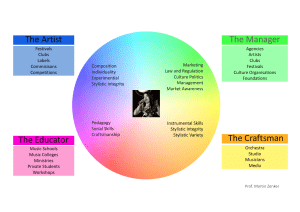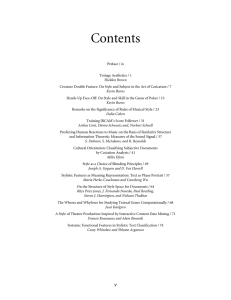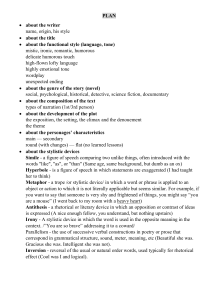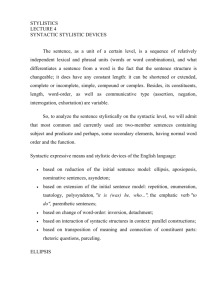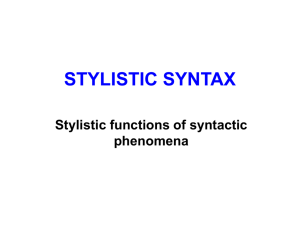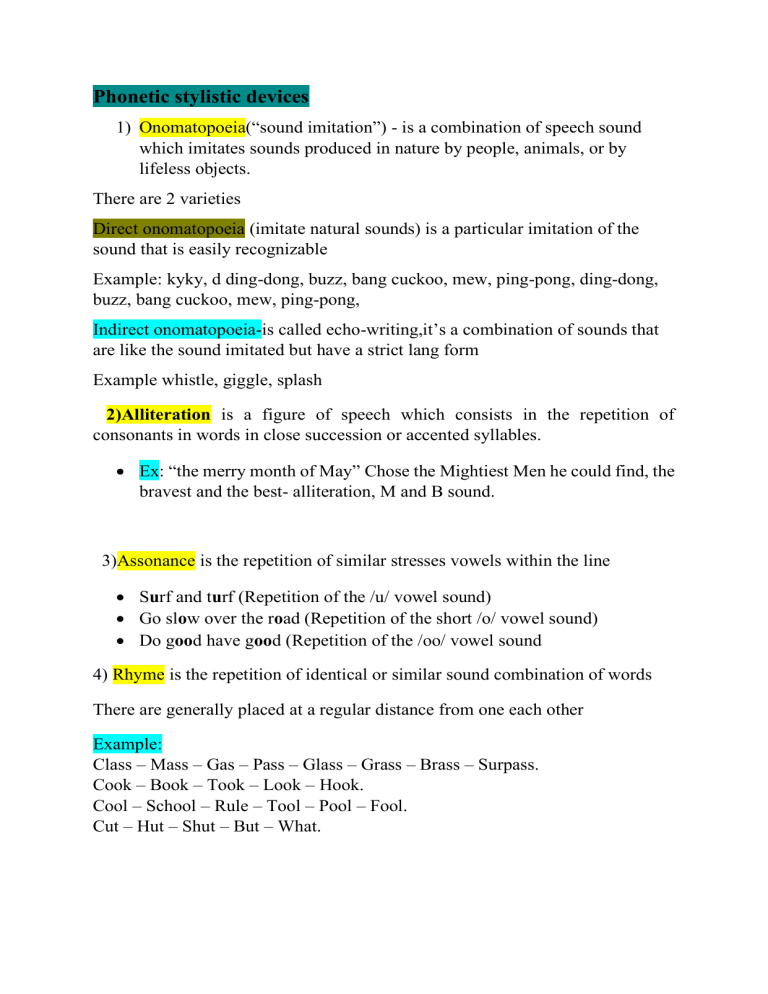
Phonetic stylistic devices 1) Onomatopoeia(“sound imitation”) - is a combination of speech sound which imitates sounds produced in nature by people, animals, or by lifeless objects. There are 2 varieties Direct onomatopoeia (imitate natural sounds) is a particular imitation of the sound that is easily recognizable Example: kyky, d ding-dong, buzz, bang cuckoo, mew, ping-pong, ding-dong, buzz, bang cuckoo, mew, ping-pong, Indirect onomatopoeia-is called echo-writing,it’s a combination of sounds that are like the sound imitated but have a strict lang form Example whistle, giggle, splash 2)Alliteration is a figure of speech which consists in the repetition of consonants in words in close succession or accented syllables. • Ex: “the merry month of May” Chose the Mightiest Men he could find, the bravest and the best- alliteration, M and B sound. 3)Assonance is the repetition of similar stresses vowels within the line • Surf and turf (Repetition of the /u/ vowel sound) • Go slow over the road (Repetition of the short /o/ vowel sound) • Do good have good (Repetition of the /oo/ vowel sound 4) Rhyme is the repetition of identical or similar sound combination of words There are generally placed at a regular distance from one each other Example: Class – Mass – Gas – Pass – Glass – Grass – Brass – Surpass. Cook – Book – Took – Look – Hook. Cool – School – Rule – Tool – Pool – Fool. Cut – Hut – Shut – But – What. 5)Rhythm is an ape ration of stresses and unstressed syllables at regular periods of time. Which serve to convey in the written form those emotions which in oral speech are expressed by intonation and stress Example: Peter Piper picked a peck of pickled peppers. Tyger, Tyger, burning bright,In the forest of the night. 6) Euphony (благозвучие) consists in a pleasing agreeable arrangement of sounds which is in harmony with the general tonality of the text and usually produces an artistic impression: a poem. Example: “Those evening bells” Graphical stylistic devices They serve to convey in the written form the effects which in the oral type of speech are expressed by intonation and stresses. We refer here the emphatic use of the punctuation and deliberate change of the spelling of a word. Graphon is the intentional vacation of the graphical shape of a word (word combination) used to reflect its authentic pronunciation. Graphons indicate irregularities, carelessness of pronunciation, foreign accent gimme (give me) ; leme (let me); gonna (going to) Punctuation Marks are not only used for expressing oral speech in writing, but they also serve for designing other SDs and EMs. For example, suspension marks(…) are used in aposiopesis to convey the speaker’s deliberate break in the utterance for certain reasons. Apart from suspension marks, dashes(тире) can be used for the same purposes: E.g.Stop teasing your sister or…= Stop teasing your sister or– Quotation marks are used for presenting the exact utterance of the speaker: E.g. “I simply can’t do it.” He said, “I don't care. Brackets([ ]), as well as comas and dashes, help the author present some additional information; they are widely used in designing insertions and other types of detached constructions: E.g.She was seventy,still in excellent health,a short sturdy woman. Exclamation marks express highly emotional speech: E.g.You just can’t leave me now! Multiplication (the repetition of the same letter or a combination of letters) is another very powerful graphic EMs, which helps to render the person’s manner of speaking: E.g.Nnooooooooo! Pleeeeeease don’t hurt me. E.g. D-don’ts-stopn-now. Graphon is a intentional violation of spelling of the word or a word combination used to reflect its authentic pronunciation: E.g.“Thquire!.. yourthervant!Thithitha badpiethofbithnith,thith ith…” (i.e. “Squire!.. Your servant! This is a bad piece of business, this is…”) Capitalization is the use of capital letters in the text of utterance to convey the speaker’s very emotional state, or to draw the reader’s attention to certain details, etc. The person’s emotional state, or his/her deliberate intention to give more prominence to certain pieces of their utterance can also be expressed with the help of italics: E.g.She was simple beautiful. E.g.I’ll NEVER see him again. Hyphenation(or the use of hyphens) is another way of reflecting the person’s manner of speaking, which is often combined with other graphic EMs: E.g.“His wife,” I said. “W-I-F-E.” Bold type(жирный шрифт) is the EMs widely used in different kinds of styles (often combined with capitalization or italics) to draw the reader’s attention to the text. It is frequently used in titles and headlines, which we used in this book as well. Graphical imagery(картинки) is designing the text in such a way so that it visually resembled its content. Syntactic stylistic devices (continuation): Ellipsis is a syntactic stylistic device based on reduction of the initial sentence model. An elliptical sentence usually has no subject or no predicate or both. The main parts of elliptical sentences are omitted by the speaker intentionally to spare his time or to save him from needless effort. Elliptical structures may reveal some emotions as: excitement, impatience and so on. As a stylistic devise, ellipsis is also an effective means of the character’s portrait. E.g. - What are you doing? - Thinking (Instead of I am thinking) • [...] The Eagle has landed." (Astronaut Neil Armstrong) • (Original: "Houston, Tranquillity Base here. The Eagle has landed." • Aposiopesis (break in the narrative) is a syntactic stylistic device based on reduction of the sentence. It is realized through incompleteness of sentence structure but unlike ellipsis, aposiopesis appears when the speaker is unwilling to proceed and breaks off his narration abruptly. This abruption is usually marked with three dots. E.g. If you go on like this… (If you go on like this I will be angry/stop talking to you/etc.) I’m so angry, I could – I could- Nominative sentences belong to syntactic stylistic devices based on reduction of the sentence structure. A nominative sentence is a variant of one member structures. It has neither structures, nor predicate. It is called nominative, because its basic component is a noun or a noun-like element (gerund or numeral) E.g. October. Morning. Problems. Noise. We walked home. We=pronoun subject in nominative case. A sequence of nominative sentences makes description of events more dynamic. They usually depict the time of the action, the place of the action, the participants of the action and so on. Inversion is a stylistic syntactic device, based on change of word order. Inversion can be grammatical and stylistic. Inversion as a stylistic phenomenon is intentional changing word order to emphasize the part of the sentence E.g. To her family Anna gives all her time (Anna gives all her time to her family) Little did he know! Detachment is a syntactic stylistic device, based on change the word order. Detached construction is a secondary part of a sentence, placed so. That it seems formally independent of the word it logically refers to. The detached part being torn away from its referent assumes a greater degree of significance. E.g. He rose up, failed, and with fury in his eyes (and with fury in his eyes – detachment) “I want to go,” he said, miserable. Parallel constructions belong to syntactic stylistic devices based on interaction of syntactic structures in context. Parallel construction or parallelism produces two or more syntactic structures according to the same syntactic pattern. E.g. Marry cooked dinner, John watched TV, Pete played tennis. (Structure is the same) Stylistic parallelism is polyfunctional. It creates rhythm in poetry, makes speech persuasive in the publicistic style, highlights important information in everyday speech. Whether at home or at work, he was always busy • Rhetoric questions belong to syntactic stylistic devices based on transposition of meaning and connection of the parts. Rhetoric questions are not grammatical questions and often affirmative or negative sentences put into the interrogative shape. A rhetoric question needs no answer because the answer is usually quite obvious. Can birds fly? Shit 1. Onomatopoeia: ◦ plop crunch cluck hiss sniff 2. Alliteration ◦ (120-121) Chose the Mightiest Men he could find, the bravest and the bestalliteration, M and B sound. ◦ (1-2) “powerful monster...growled in pain, impatient” ◦ (60-61) so Heorot Stood empty, and deserted for years ◦ "A moist young moon hung above the mist of a neighboring meadow." ◦ Ida brought fancy flowers to Molly’s birthday party. 3. Rhyme ◦ and still they rock and rock and rock beside a cold indifferent clock. ◦ Red sky in the morning: sailors take warning Red sky at night: sailors’ delight ◦ The road goes ever on and on, Down from the door where it began. Now far ahead the road as gone And I must follow if I can. ◦ Whose woods these are I think I know. His house is in the village though; He will not see me stopping here To watch his woods fill up with snow. ◦ “Twinkle, twinkle little star How I wonder what you are” 4. Rhythm ◦ Tyger, Tyger, burning bright, In the forest of the night. ◦ How do you pray looking at the tray ◦ “Will there really be a morning?Is there such a thing as day? ◦ shall i compare thee to a summers day ◦ I think that I shall never see a poem lovely as a tree.
